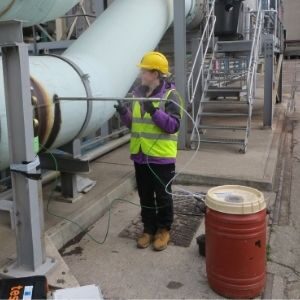ODOUR MEASUREMENT: HOW TO MEASURE ODOUR

ODOUR MEASUREMENT
At Silsoe Odours, we provide our clients with information about the odorous emissions produced by your processes. We can objectively measure, assess and analyse odours, all in line with international odour measurement standards. So the question is, how do we do this?
HOW TO MEASURE ODOUR
Generally speaking, we use two methods of odour measurement.
We commonly measure odour by taking samples from a site and analysing them in our UKAS-accredited odour laboratory, using dynamic olfactometry. This is called an odour sampling survey. Our analysis results help you to understand the scope and the characteristics of odour emissions at your site. You will find this useful for planning purposes, to comply with environmental permits or in testing odour abatement equipment.
For the second route, we send odour panellists to conduct a ‘sniff test’ of the area.
ODOUR MEASUREMENT EQUIPMENT: Sampling
Have you ever heard the mantra “proper preparation prevents poor performance”? Here at Silsoe Odours, we are entirely on board with the ‘5Ps’. That is why we begin every odour measurement project by thoroughly researching the site. We consider meteorological and physical conditions for the day of the survey. For sampling surveys, we also carefully identify the potential odour sources.
Equally important is that our team holds extensive expertise and experience. Crucially we hold UKAS accreditation for odour sampling and testing.
Finally, it is essential that we use the right odour measurement equipment. We carefully select the right tools for each job. Here is a quick run-down of some of the equipment we use.

At Silsoe Odours we manufacture and test Nalophan odour sample bags in our UKAS-accredited laboratory.
Nalophan Odour Sampling Bags
When we are at a site, we collect odour samples using Nalophan odour sampling bags. We manufacture and test the bags in-house at our laboratory according to the requirements of European odour standard EN13725:2022. Indeed we are accredited to do so, according to ISO17025.

We attach sample bags to direct point sources where there is positive pressure. Otherwise, we use a rigid lung barrel to evacuate the air and draw the odour sample into the bag.
Rigid Lung Barrels
We will attach the Nalophan odour sample bag to direct point sources where there is positive pressure. Otherwise, we use a rigid lung barrel to evacuate the air using a vacuum pump to draw the odour sample into the bag.

To measure odour from open sources, we use a Lindvale Hood
Lindvall Hood
A Lindvall hood is a piece of equipment that allows us to measure odour from open sources. We place the hood over a particular source and allow it to fill. Once complete, we can draw off the odour from the hood using a Nalophan sample bag and rigid lung barrel.

Using a dilution probe, we can dilute a sample at the source and stop condensation from forming, producing more accurate odour measurement results.
Dilution Probe
Sometimes we may need to dilute a sample at the source to stop condensation from forming. In this case, we will use a dilution probe. When we prevent condensation from forming, we can ensure more effective odour measurement.
ODOUR MEASUREMENT EQUIPMENT: Testing
Once we have collected odour samples, we return them to our laboratory for testing and analysis. To do this, we use a process of dynamic olfactometry.

The human nose is the most effective sensor of odour and, therefore, our most important piece of odour measurement equipment
Noses
The only effective sensor of odour is the olfactory organ. In other words, the human nose. Therefore, we consider it our most critical piece of odour measurement equipment. We use a panel of carefully selected, screened and trained assessors (‘odour panel members’) to conduct our olfactometry testing.
Specialist odour panellists also conduct ‘sniff surveys’.

The olfactometer is used to dilute and present odour samples to our specialist odour panel.
Olfactometer
The olfactometer is a device that dilutes an odour sample to a known concentration. We then use the olfactometer to present the sample to our specialist odour panel. The odour panellists then take part in a ‘forced choice’ progression of odour assessment until they have established the odour concentration of the sample. In addition to odour concentration, we can also test samples for chemical analysis, odour detection threshold, odour intensity and odour characterisation.
FIND OUT MORE ABOUT ODOUR MEASUREMENT
So you should now have a good idea of what goes into measuring odour, from preparation to collection to analysis. However, if you have any queries, we would be more than happy to help. Our team has many years of expertise and experience and can help with your odour challenge. In the first instance, you can reach us by calling 01525 860222 or by clicking the button below. You can also follow us on LinkedIn, Twitter and Facebook to keep up with the latest news from the team.
Article updated 7 February 2024.
